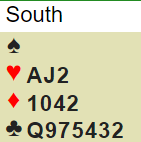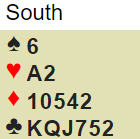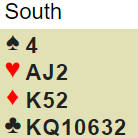AuthorSince moving to the USA, I have played less bridge than I am used to. But I have played enough to note that Bergen raises are very popular. They are so popular that I will not have to explain what they are to develop this article. A good source for it is found in Larry Cohen's bridge website, for those who are interested. (If you go there, by the way, you'll see that he also advocates not using Bergen raises, raising basically the same point I am discussing in this longer article). It is important to understand, nevertheless, the motivation behind Bergen raises, so as to better criticize them, and to suggest better alternatives. Bergen raises were created to exploit to the greatest extent the Law of Total Tricks. This concept deserves articles and books (and they have been written), but for our purposes, and in the realm of major suit raises, the salient point is that with nine trumps you have 3-level safety. If we want to unpack this sentence, its meaning is that if you have a nine-card fit, you will either make your contract or, if you go down, the odds are that your opponents could make a contract of their own. In those books I mentioned, this area of bidding -- competition at the 3-level for the partscore -- is thoroughly explored. And the idea behind Bergen raises is that, if you are aware of your nine-card fit, you should take up as much space as possible, and bid directly at the 3-level (your safety level). This is why the bids of 3 Clubs and 3 Diamonds become dedicated for major suit raises. So far so good. But any convention must be analyzed in reference to the whole picture, namely, what are you giving up to play it? And what are the extra chances you are offering to the opponents by playing it? These questions are often neglected, with the players focusing only on the gains of the convention. The major drawback of Bergen raises is that they are pretty much incompatible with 2/1 GF. Yes, you heard me. One of the most popular systems in America right now includes both 2/1 GF and Bergen raises -- and this leaves an enormous, unsolvable gap in your system. When you use the bids of 3 Clubs and 3 Diamonds to support partner, you no longer have them available in their natural sense. This means that any hand in which the primary suit is clubs (or diamonds) cannot use any other route than bidding its suit at the 2-level, or 1NT. But the 2-level new suit is game forcing! And so we have a huge range of club (and diamond) hands that are shoveled into the forcing 1NT response. (If you play it as semi-forcing, meaning that your partner can pass with a balanced minimum, your problem becomes even worse). Look at the 3 hands below. You want to bid clubs with these 3 hands. Playing 2/1 and Bergen, if you partner opened 1 Spade, you have to bid 2 Clubs (game forcing) with the 3rd, and the other 2 hands have to start with 1NT. How can you distinguish between them when partner rebids 2 Spades? Short answer is, you can't.
One solution that allows you to keep your Bergen raises is to play that the 2/1 response is not always game forcing -- that if you rebid your suit, you have invitational values. Then you create some problem for you with the 3rd hand (you'll have to rebid unnaturally in your 2nd turn, probably 2NT. Lucky that I gave you stoppers. You might be missing them). As you see, this is the "short blanket" problem -- you have 3 hands but only 2 bids. The easy solution is to find a 3rd bid for the 3rd hand. One way to do this is by saying bye bye to Bergen and playing the jump to 3 of a minor as invitational. Now you can bid 1NT with the 1st hand, 3 Clubs with the second hand, and 2 Clubs (GF) with the 3rd hand, planning to rebid your clubs (particularly if you lack stoppers in a red suit). So, what do we do with those 4-card raises in the 6-11 range, if you give up Bergen? After all, the principle of "heading to the 3-level with 4 card support" is still sound. The easiest and most natural way to do it is to bid 3 of a major as a mixed raise, something like 7-9 with 4 trumps. You are giving up the more preemptive version (4-6) that is standard Bergen -- with this hand you raise at the 2-level. It is not ideal. Bergen does have some advantages, after all. It would be better to jump to the 3-level if you could do it using all of your legal bids. Don't lose heart, though -- if your opponent interferes (with a double or an overcall) before you bid, your jump reverts to preemptive (something like 4-7, with an eye on the vulnerability), With 10-11 and 4 trumps, I recommend you jump to 2NT. But isn't this Jacoby, a game-forcing raise? Sure, but it is quite easy to adapt it to include the 10-11 hands. Jacoby then becomes a hand in the range 10-16. The sequences I will present here not only take care of the 10-11 hands, but they also are a major improvement over "standard Jacoby", which reveals too much of opener's hand when this is not necessary. As any new convention, it takes some study and effort to master it, but here it goes. After 1 Major - 2NT (10-16):
This is merely one of many available solutions to the question "if not Bergen, what?" Agreeing that 2/1 bids can be of (only) invitational strength if you rebid your suit is also a good way out of this problem (which will leave you maneuvering a bit unnaturally if you have a game-forcing one-suiter -- but strong hands can often sort themselves out). More high-tech approaches would use a 2 Clubs game-forcing relay to bid some of these hands with good support; some top partnerships bid 2NT as a limited raise (7-11 or such), keeping the preemptive (4-6) raise, and use a slower path with any game forcing raise. If there is a demand for a description of that alternative, I will write another article about it. But it is very much more complicated. For most partnerships who are looking for a consistent 2/1 system, my recommendation is:
1 Comment
Pippa Hooper
3/6/2023 08:31:48 pm
Hello Paulo
Reply
Leave a Reply. |
Archives
September 2021
Categories
All
|



 RSS Feed
RSS Feed